
Tax and NIC thresholds for 2021/22
7 Mar 2021If you’re a business owner, you’ve probably been eagerly awaiting news from HMRC about the 2021/22 thresholds for income tax, statutory payments, and national insurance contributions (NIC). They’re just a few of the things that got disrupted during what was an extraordinary 2020, and it’s caused some inconvenience because the thresholds and rates for NIC requirements would usually have been released by the Chancellor as part of the Autumn Statement or the Autumn Budget.
Because of the COVID-19 pandemic, the 2020 Autumn Statement never happened. It’s likely we’ll to have to wait until March 2021 for the Budget to find out for certain how rates will be affected, but the financial secretary to the treasury, Jesse Norman, did deliver a ministerial statement concerning increases in the NIC thresholds back in December last year:
“In line with the approach set out in the Spending Review document on 25 November (CP 330), the Government will use the September Consumer Price Index (CPI) figure (0.5%) as the basis for setting all National Insurance limits and thresholds, and the rates of Class 2 and Class 3 National Insurance contributions, for 2021-22. A table of these 2021-22 National Insurance rates and thresholds will be placed in the Libraries of the House.”
Class 1 2021 – 2022
|
Class 1 NIC: Employee and Employers (£ per week) |
||
|
2020-21 |
2021-22 |
|
|
Weekly lower earnings limit |
£120 |
£120 |
|
Weekly primary threshold |
£183 |
£184 |
|
Weekly secondary threshold |
£169 |
£170 |
|
Upper earnings limit |
£962 |
£967 |
|
Upper secondary threshold for under 21s |
£962 |
£967 |
|
Apprentice upper secondary threshold for under 25s |
£962 |
£967 |
Class 2 2021 – 2022
|
Class 2 NIC: Self-employed (£ per week) |
||
|
2020-21 |
2021-22 |
|
|
Small profits threshold (£ per year) |
£6,475 |
£6,515 |
|
Class 2 contribution rates |
2020-21 |
2021-22 |
|
Annual profits (£ per year) |
£ per week |
£ per week |
|
Below small profits threshold |
£3.05 voluntary |
£3.05 voluntary |
|
Above small profits threshold |
£3.05 |
£3.05 |
Applicable for the self-employed during 2021/22:
-
The small profits threshold has increased from £6,475 to £6,515
-
The weekly rate stays at £3.05 per week
Class 3 2021 – 2022
This is the class of NIC that can be used to fill in any gaps that may exist in a person’s NIC record. You can check your personal tax account for gaps, and you may need to pay voluntary contributions in order to fill them. For 2021/22 the weekly rate will increase from £15.30 to £15.40.
|
Class 3 NIC: Voluntary Contributions (£ per week) |
||
|
2020-21 |
2021-22 |
|
|
Voluntary contributions |
£15.30 |
£15.40 |
Class 4 2021 – 2022
Where self-employed profits work out higher than the lower profits limit (LPL) class 4 NIC will be payable. These are the figures for 2021/22:
-
The LPL has increased from £9,500 to £9,568
-
The upper profits limit has increased from £50,000 to £50,270
|
Class 4 NIC: Self-employed (£ per week) |
||
|
2020-21 |
2021-22 |
|
|
Lower profits limit |
£9,500 |
£9,568 |
|
Upper profits limit |
£50,000 |
£50,270 |
Read More: How To Pay Self-assessment Tax & Deadlines
Income tax implications
The class 1 upper end limit has increased by £270 from £50,000 to £50,270. The upper end limit has been aligned to the income tax higher rate threshold since 2007, so English, Northern Irish, and Welsh taxpayers will have a higher rate threshold of £50,270.
The personal allowance and basic rate
The 2020 Spending Review specified an increase in the 2021/22 income tax personal allowance and higher rate threshold that lines up with September’s consumer price index figure of 0.5%. So, the personal allowance increases from £12,500 to £12,570, and the basic rate threshold will be £37,700 in 2021/22.
Pensions implications
The class 1 lower end limit stays unchanged, so that will be £120 per week. That works well for the average weekly earnings threshold for statutory payments. It’s also reasonable to assume that the lower qualifying earnings band related to workplace pensions will not change either.
State pensions and benefits
The secretary of state for work and pensions, issued a statement back in November, and these were the main implications for state pensions and benefits:
-
Basic and new state pensions will increase by 2.5% starting on 12 April this year.
-
Other state benefits will increase according to the consumer price index rate of inflation, which is 0.5%.
Statutory Sick Pay (SSP)
The weekly rate for statutory sick pay will increase from £95.85 to £96.35, and that will apply to average weekly earnings equal to or above the lower end limit. The new rate of statutory sick pay must be paid from 6 April onwards.
|
Unrounded daily rates |
No. QDs in week |
Number of days due |
||||||
|
1 |
2 |
3 |
4 |
5 |
6 |
7 |
||
|
£ |
£ |
£ |
£ |
£ |
£ |
£ |
£ |
|
|
13.7643 |
7 |
13.77 |
27.53 |
41.30 |
55.06 |
68.83 |
82.59 |
96.35 |
|
16.0583 |
6 |
16.06 |
32.12 |
48.18 |
64.23 |
80.30 |
96.35 |
|
|
19.2700 |
5 |
19.27 |
38.54 |
57.81 |
77.08 |
96.35 |
||
|
24.0875 |
4 |
24.09 |
48.18 |
72.27 |
96.35 |
|||
|
32.1167 |
3 |
32.12 |
64.24 |
96.35 |
||||
|
48.1750 |
2 |
48.18 |
96.35 |
|||||
|
96.3500 |
1 |
96.35 |
||||||
Read More: Paying Wages & Sick Pay for Employees During Covid-19
Parental Pay
Remember, even though statutory sick pay must be paid from the start of the new tax year, other statutory payments start on the first Sunday in April – which falls on the 4th in 2021. The parental payments weekly rate rises from £151.20 to £151.97.
Get help with tax and bookkeeping from an experienced accountant
Tax can be complicated, and you can face fines if you make a mistake on your tax return. Our team of small business accountants and online accountants can help both small and medium business owners and the self-employed get it right. We can also help with VAT returns, corporation tax, business expenses, and self-assessment.
Get in touch with us today on 0207 043 4000 or through emailing info@accountsandlegal.co.uk for further advice, or try our instant accounting quote tool and we will be in touch shortly.
Click the link for more tax advice.





















